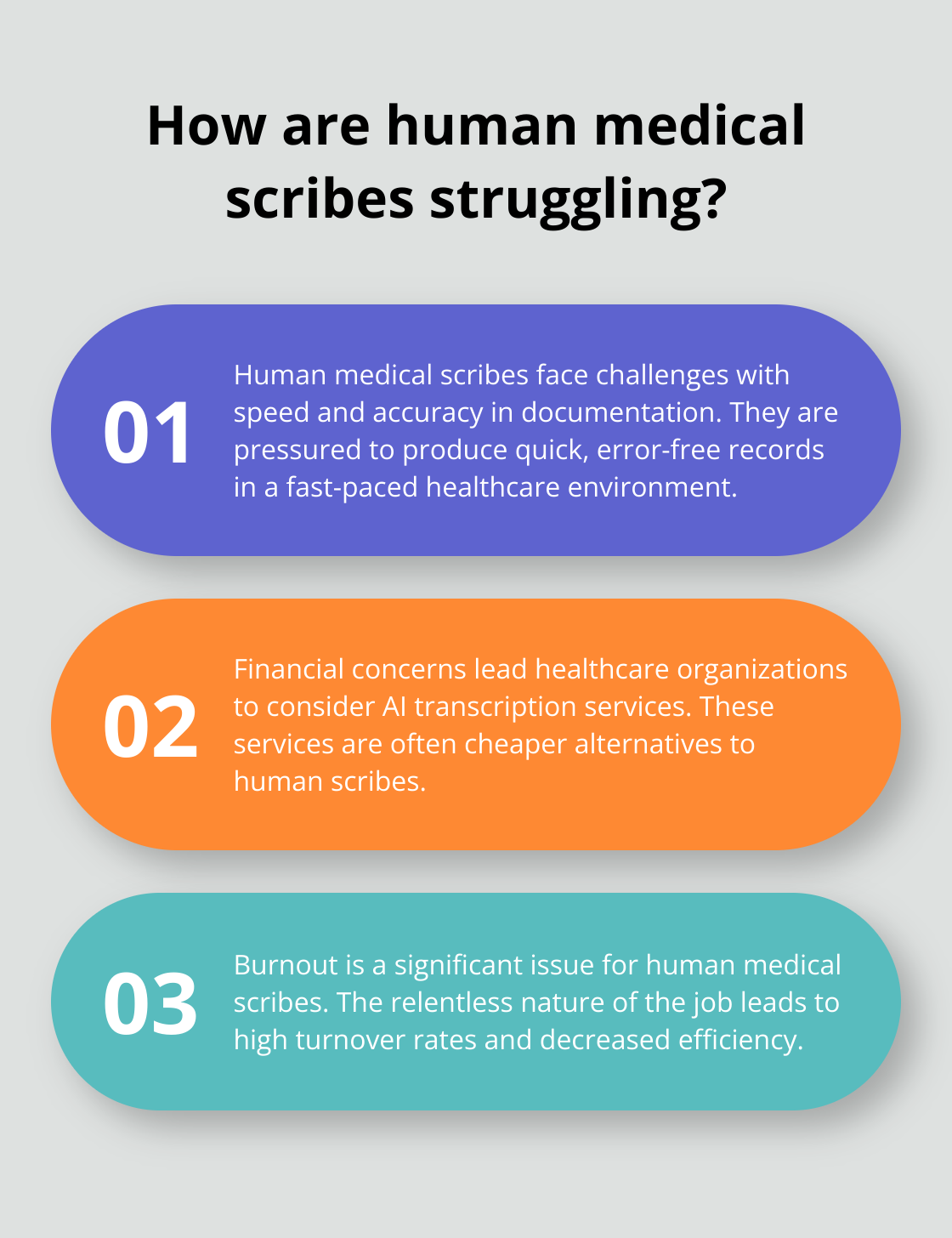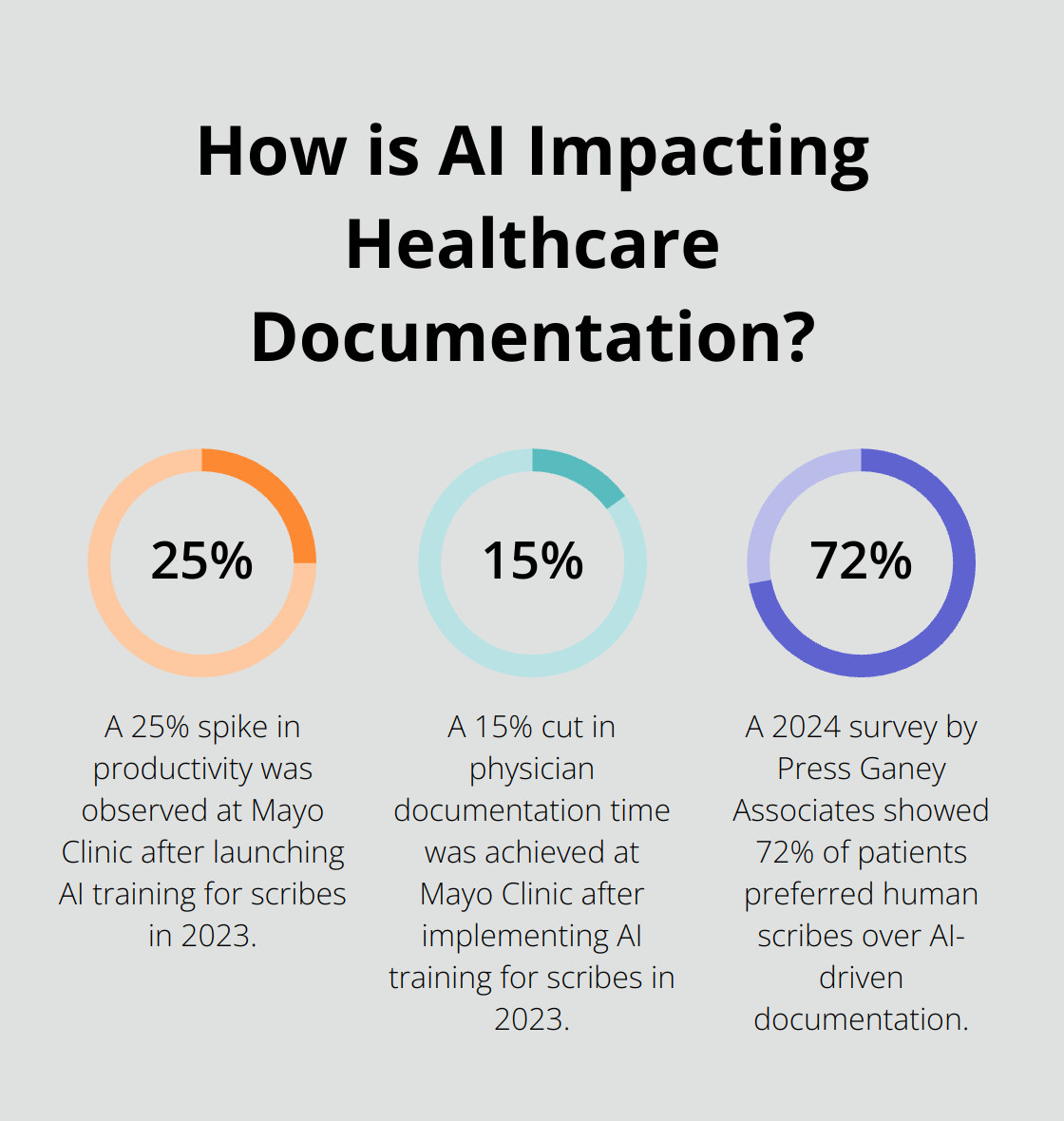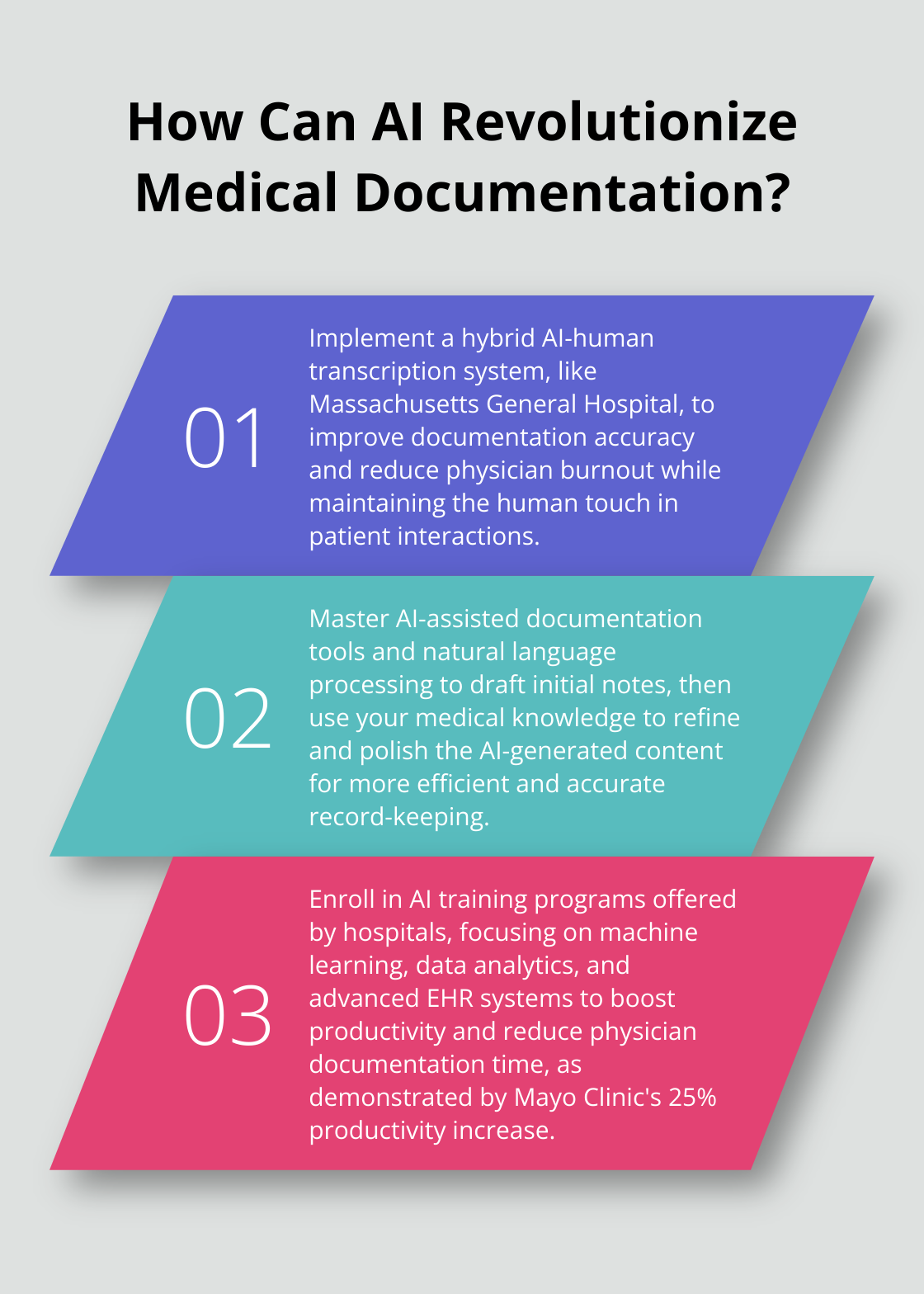Medical scribes in 2025—what’s the deal? AI-powered transcription tech is zooming ahead faster than a Tesla in Ludicrous Mode, leaving healthcare providers (and their human scribes) scratching their heads about what comes next.
Over at ScriberJoy, we’ve been right at the epicenter of this AI-driven upheaval in medical documentation. But here’s the million-dollar question: Are medical scribes on the road to obsolescence?
AI’s Transformation of Medical Transcription
The Evolution of Medical Documentation
Medical transcription, folks, has done a total 180 since its humble beginnings. Imagine this: In the early 1900s, doctors were laying down notes on wax cylinders… like spinning outdated records. Now, zoom to 2025, and we’re smack dab in a techno-revolution that would’ve seemed straight out of a sci-fi flick.

According to the 2024 report from those brainiacs over at the Healthcare Information and Management Systems Society (HIMSS), a whopping 78% of healthcare providers are now on board with AI-assisted transcription. That’s a big leap from 35% back in 2020-talk about blasting off with this tech.
AI’s Advantages in Healthcare Documentation
AI in transcription land? Game-changer, hands down. These tools crank out medical notes in real-time, hitting crazy-good accuracy rates of up to 95%. And let’s not kid ourselves-in healthcare, even a tiny slip-up can be a big deal.
These AI marvels? They never sleep-they’re on the job 24/7, no breaks, no sick days. Thanks to this relentless pace, documentation backlogs have been sliced by 40%, as per last year’s American Health Information Management Association’s (AHIMA) report. Not too shabby.
The Impact on Human Medical Scribes
AI’s making waves, no doubt, but that’s got the traditional medical scribes sweating a little. The U.S. Bureau of Labor Statistics says we’re looking at a 7% dip in medical transcriptionist gigs over the next eight years-pretty clear sign that this job market is doing some serious shuffling.
Is it all doom and gloom? Nah, not quite. A lot of healthcare out there is going for a blend, a mash-up of AI transcription with human oversight. Think fast-paced AI efficiency blended with that deep, smart human touch.
The Hybrid Approach: Humans and AI in Harmony
Take Massachusetts General Hospital, for example-they’re rolling with a hybrid AI-human transcription system. The results? Better documentation accuracy, less physician burnout… basically checkmate on all fronts. This goes to show AI can tag-team with humans to supercharge transcription workflows.
So, AI’s making its mark on medical transcription, that’s certain. But don’t overlook the human factor-it’s still got game. For medical scribes in 2025 and beyond, the play is clear: Learn, adjust, and find that sweet spot where AI and human skills complement each other like peanut butter and jelly.
As the clock ticks on, this whole medical documentation scene? It’s got its foot on the accelerator. Next up, we’ll dive into the wrangling going on among human medical scribes as they navigate these twisty turny tech landscapes.
The Uphill Battle for Human Medical Scribes
Speed vs. Accuracy: A Tightrope Walk
Human medical scribes are climbing Everest with flip-flops-trying to keep pace with today’s turbocharged healthcare tempo. Boom… the need for lightning-fast, error-free documentation is shooting through the stratosphere. These folks? Straining under the pressure of modern medicine’s relentless push for speed, speed, and more speed.

Here’s the ugly reality: healthcare honchos want documentation yesterday. This gotta-be-quick-or-else demand puts scribes in a chokehold, forcing a brutal choice between accuracy and timeliness-kinda like choosing between oxygen and water.
The Financial Squeeze
Let’s talk dimes and nickels. Cost-cutting bean counters have these healthcare outfits questioning their reliance on human scribes. Enter AI transcription services-cheaper by a mile and (if you squint) sexy to budget-watchers. A no-brainer, right? Until it’s not.
Burnout: The Silent Scribe Killer
It’s a grind, folks. The job? It’s relentless-and it’s chewing up human medical scribes like popcorn. Sure, providers rave about scribes boosting their job happiness and warding off burnout by lightening the paperwork load. But the high-octane environment-it’s a conveyor belt of burnout, turnover… rinse and repeat. All that on-boarding ain’t cheap. Efficiency? Plunging.
The AI Challenge
AI-the shiny new kid-posing a challenge to classic scribing. But hey, let’s not toss the baby with the bathwater. That special human touch in medical docs? Priceless. The real trick here is striking a sweet spot: tech power with human warmth. A collision of circuits and empathy.
Forward focus: human scribes have to get with the program-literally. Evolving is the name of the game-melding their skills with tech innovations to keep their stake in the future of medical docs. Buckle up… the next chapter dives into how scribes can blend old-school know-how with new-world tech to hang onto their spots in the healthcare ecosystem.
How Medical Scribes Will Evolve in 2025
The Transformation of Medical Scribing
So, medical scribes-are they dinosaurs heading for the tar pits? Not quite. Fast forward to 2025 and boom, they’re transforming instead of fossilizing. We’re talking about a transformation so big it’s like watching a caterpillar become a butterfly… if the butterfly could code. Scribes blend their irreplaceable human touch with next-level AI. This isn’t just a shuffle-it’s a tectonic shift in healthcare documentation. And for those scribes with the grit to adapt? Opportunity galore.
The New Breed of Medical Scribes
Meet the new scribes. They’re not just jotting down “patient has a cold” anymore. Tech-savvy? You bet. These professionals wield AI like a power tool-supercharging their efficiency. Transcribers? Nope. Now they’re data analysts, quality control wizards, and AI whisperers. Streamlined documentation is their game, cutting bottlenecks like a hot knife through butter, getting patients in and out faster than ever.

We’re talking about scribes mastering AI-assisted documentation like a boss. They kick off with natural language processing to draft notes, then they bring in the human touch-medical knowledge-to finesse those AI-generated drafts into polished gems. The results? Stunning. AI medical scribes are time-savers extraordinaire, chopping down doctor-hours on paperwork while pumping up efficiency and patient care with precision and security.
Upskilling: Staying Relevant in an AI World
Thinking about thriving in 2025 and beyond? Then buckle up, scribes. It’s time for lifelong learning. The scribes who soar are the ones seeing AI as a sidekick, not an arch-nemesis. They dive deep into machine learning, data analytics, and advanced EHR systems.
Hospitals are in on this gig-take Mayo Clinic, launching its AI training for scribes in 2023. The results were anything but meh: a 25% spike in productivity, a 15% cut in physician documentation time. Not too shabby.
The Human Edge in an AI-Driven Landscape
AI might be rewriting the playbook, but human scribes aren’t benched yet. They’ve got the ace-empathy and context. A 2024 survey by Press Ganey Associates showed 72% of patients preferred the chit-chat and assurance of human scribes over robo-writers.
This human touch? Priceless in tricky medical situations. AI might miss nuances, but seasoned scribes? They’re capturing details, reading non-verbal cues, catching emotional undertones-stuff even the smartest AI just can’t do (yet).
As 2025 rolls out, the horizon for medical scribes? Bright. But here’s the deal-only for those who evolve. Scribes blending their human smarts with AI savvy elevate healthcare documentation to dazzling new heights. It’s not a steel cage match between man and machine-it’s a harmonized duet delivering stellar patient care.
Final Thoughts
So, we’re staring down the barrel of a massive shift in healthcare documentation – medical scribes are on the brink of a big transformation. AI-powered solutions are crashing the party, bringing speed and efficiency we’ve never seen before. But let’s not get ahead of ourselves; there’s still this thing called the human touch, and scribes are packing empathy and nuanced understanding that robots just don’t have in their playbook.

We’re likely heading into this future where medical scribes and AI work hand-in-hand, playing off each other’s strengths. Scribes are morphing into these hybrid roles – think medical savvy meets tech whiz. They’ll be herding AI systems, tweaking the outputs, and pretty much holding the line on accuracy and top-notch patient care.
Over at ScriberJoy, we’re pitching in with a blend of AI’s efficiency and human smarts. Our gig is all about hitting that sweet spot: lightning-fast, spot-on transcription without sacrificing the patient experience people actually care about. As healthcare keeps pushing forward, tools like ScriberJoy will be crucial in marrying tech leaps with the personal touch of healthcare.

Leave a Reply
You must be logged in to post a comment.